Paper Menu >>
Journal Menu >>
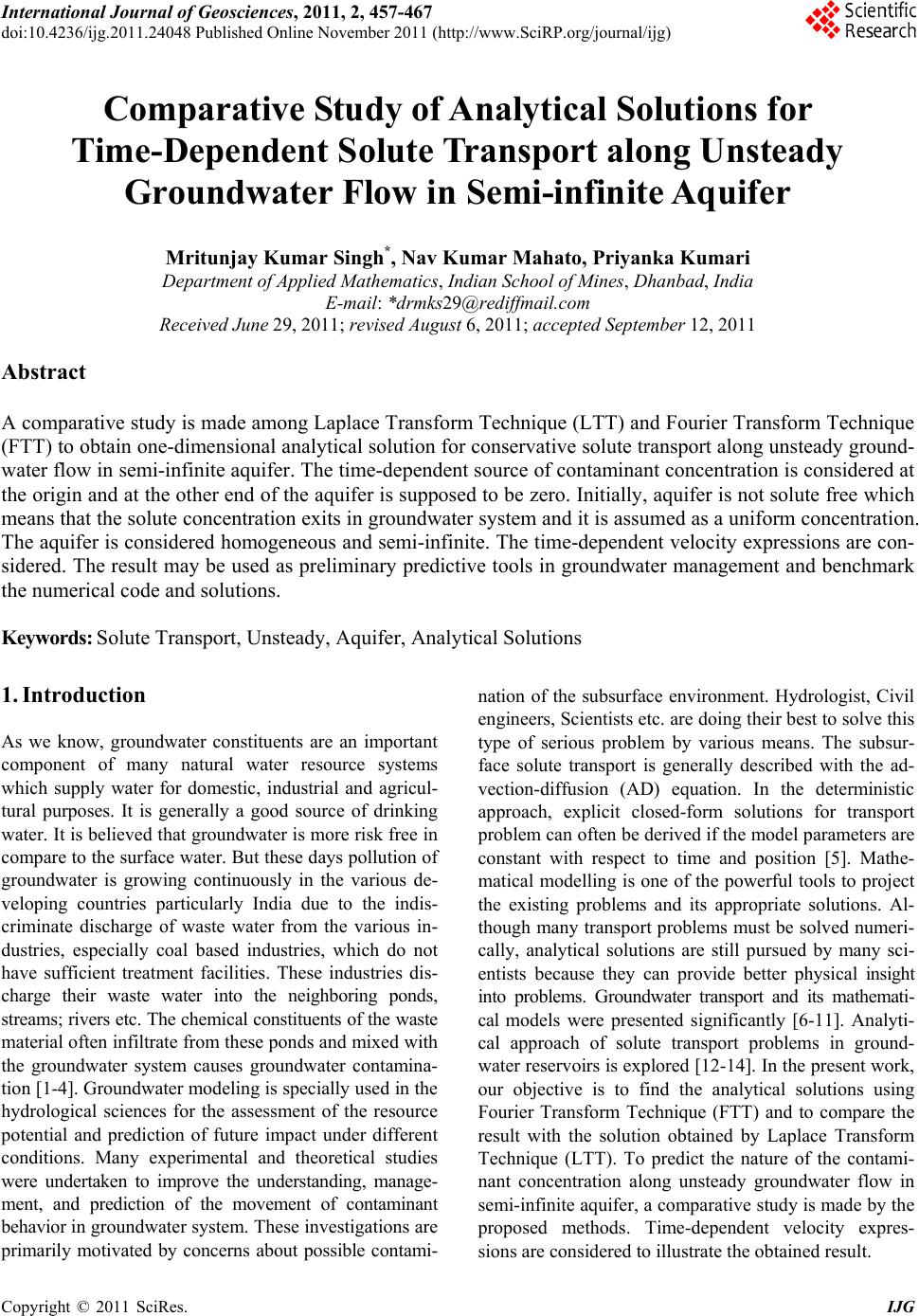 International Journal of Geosciences, 2011, 2, 457-467 doi:10.4236/ijg.2011.24048 Published Online November 2011 (http://www.SciRP.org/journal/ijg) Copyright © 2011 SciRes. IJG 457 Comparative Study of Analytical Solutions for Time-Dependent Solute Transport along Unsteady Groundwater Flow in Semi-infinite Aquifer Mritunjay Kumar Singh*, Nav Kumar Mahato, Priyanka Kumari Department of Ap pl i e d Mat hematics, Indian School of Mines, Dhanbad, India E-mail: *drmks29@rediffmail.com Received June 29, 2011; revised August 6, 2011; accepted September 12, 2011 Abstract A comparative study is made among Laplace Transform Technique (LTT) and Fourier Transform Technique (FTT) to obtain one-dimensional analytical solution for conservative solute transport along unsteady ground- water flow in semi-infinite aquifer. The time-dependent source of contaminant concentration is considered at the origin and at the other end of the aquifer is supposed to be zero. Initially, aquifer is not solute free which means that the solute concentration exits in groundwater system and it is assumed as a uniform concentration. The aquifer is considered homogeneous and semi-infinite. The time-dependent velocity expressions are con- sidered. The result may be used as preliminary predictive tools in groundwater management and benchmark the numerical code and solutions. Keywords: Solute Transport, Unsteady, Aquifer, Analytical Solutions 1. Introduction As we know, groundwater constituents are an important component of many natural water resource systems which supply water for domestic, industrial and agricul- tural purposes. It is generally a good source of drinking water. It is believed that groundwater is more risk free in compare to the surface water. But these days pollution of groundwater is growing continuously in the various de- veloping countries particularly India due to the indis- criminate discharge of waste water from the various in- dustries, especially coal based industries, which do not have sufficient treatment facilities. These industries dis- charge their waste water into the neighboring ponds, streams; rivers etc. The chemical constituents of the waste material often infiltrate from these ponds and mixed with the groundwater system causes groundwater contamina- tion [1-4]. Groundwater modeling is specially used in the hydrological sciences for the assessment of the resource potential and prediction of future impact under different conditions. Many experimental and theoretical studies were undertaken to improve the understanding, manage- ment, and prediction of the movement of contaminant behavior in groundwater system. These investigations are primarily motivated by concerns about possible contami- nation of the subsurface environment. Hydrologist, Civil engineers, Scientists etc. are doing their best to solve this type of serious problem by various means. The subsur- face solute transport is generally described with the ad- vection-diffusion (AD) equation. In the deterministic approach, explicit closed-form solutions for transport problem can often be derived if the model parameters are constant with respect to time and position [5]. Mathe- matical modelling is one of the powerful tools to project the existing problems and its appropriate solutions. Al- though many transport problems must be solved numeri- cally, analytical solutions are still pursued by many sci- entists because they can provide better physical insight into problems. Groundwater transport and its mathemati- cal models were presented significantly [6-11]. Analyti- cal approach of solute transport problems in ground- water reservoirs is explored [12-14]. In the present work, our objective is to find the analytical solutions using Fourier Transform Technique (FTT) and to compare the result with the solution obtained by Laplace Transform Technique (LTT). To predict the nature of the contami- nant concentration along unsteady groundwater flow in semi-infinite aquifer, a comparative study is made by the proposed methods. Time-dependent velocity expres- sions are considered to illustrate the obtained result. 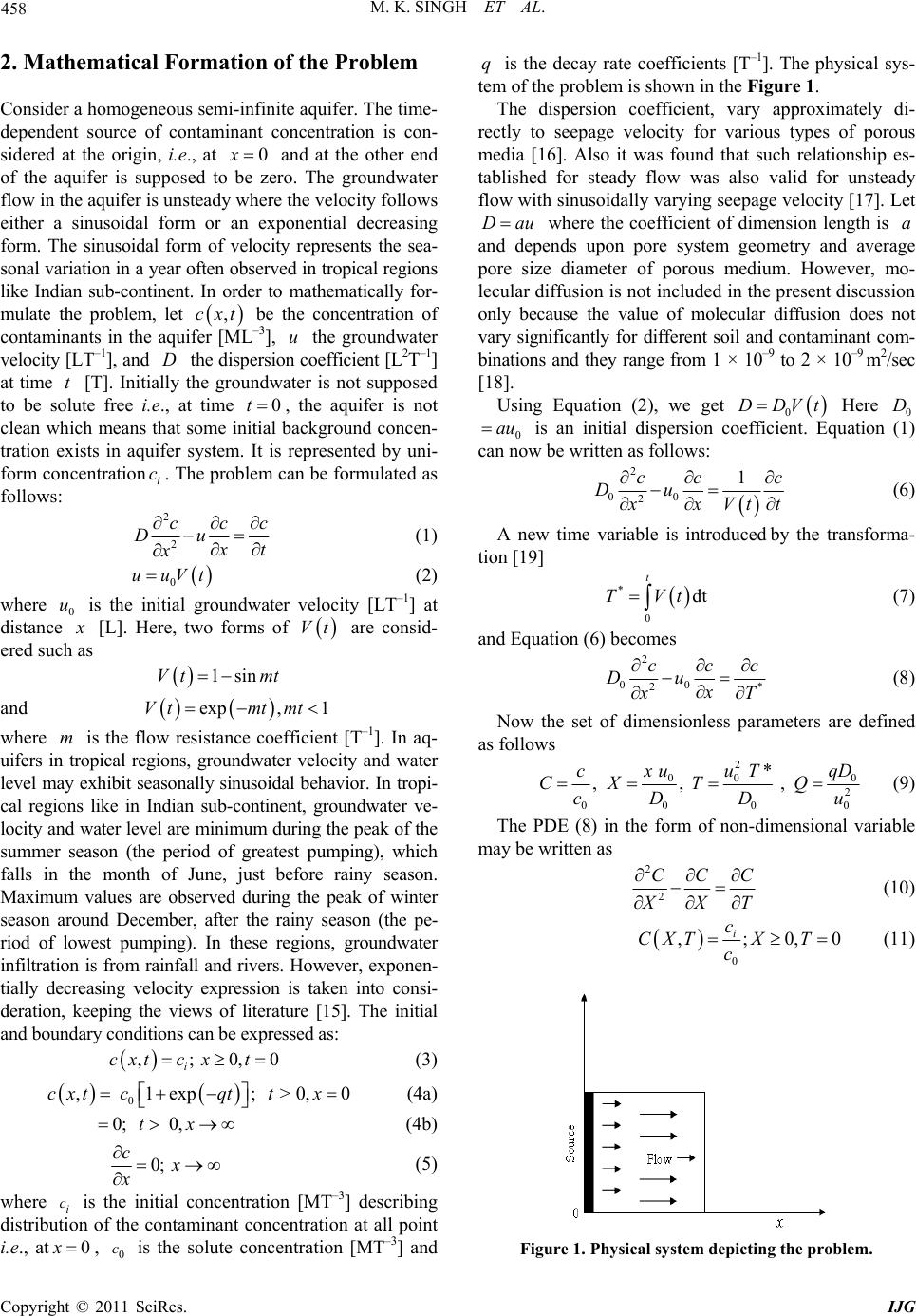 M. K. SINGH ET AL. Copyright © 2011 SciRes. IJG 458 2. Mathematical Formation of the Problem Consider a homogeneous semi-infinite aquifer. The time- dependent source of contaminant concentration is con- sidered at the origin, i.e., at 0x and at the other end of the aquifer is supposed to be zero. The groundwater flow in the aquifer is unsteady where the velocity follows either a sinusoidal form or an exponential decreasing form. The sinusoidal form of velocity represents the sea- sonal variation in a year often observed in tropical regions like Indian sub-continent. In order to mathematically for- mulate the problem, let ,cxt be the concentration of contaminants in the aquifer [ML–3], u the groundwater velocity [LT–1], and D the dispersion coefficient [L2T–1] at time t [T]. Initially the groundwater is not supposed to be solute free i.e., at time 0t, the aquifer is not clean which means that some initial background concen- tration exists in aquifer system. It is represented by uni- form concentrationi c. The problem can be formulated as follows: 2 2 ccc Du x t x (1) 0 uuVt (2) where 0 u is the initial groundwater velocity [LT–1] at distance x [L]. Here, two forms of Vt are consid- ered such as 1sinVt mt and exp, 1Vtmt mt where m is the flow resistance coefficient [T–1]. In aq- uifers in tropical regions, groundwater velocity and water level may exhibit seasonally sinusoidal behavior. In tropi- cal regions like in Indian sub-continent, groundwater ve- locity and water level are minimum during the peak of the summer season (the period of greatest pumping), which falls in the month of June, just before rainy season. Maximum values are observed during the peak of winter season around December, after the rainy season (the pe- riod of lowest pumping). In these regions, groundwater infiltration is from rainfall and rivers. However, exponen- tially decreasing velocity expression is taken into consi- deration, keeping the views of literature [15]. The initial and boundary conditions can be expressed as: ,; 0,0 i cxtc xt (3) 0 , 1exp; > 0,0 cxt cqttx (4a) 0; 0, tx (4b) 0; cx x (5) where i c is the initial concentration [MT–3] describing distribution of the contaminant concentration at all point i.e., at0x, 0 c is the solute concentration [MT–3] and q is the decay rate coefficients [T–1]. The physical sys- tem of the problem is shown in the Figure 1. The dispersion coefficient, vary approximately di- rectly to seepage velocity for various types of porous media [16]. Also it was found that such relationship es- tablished for steady flow was also valid for unsteady flow with sinusoidally varying seepage velocity [17]. Let Dau where the coefficient of dimension length is a and depends upon pore system geometry and average pore size diameter of porous medium. However, mo- lecular diffusion is not included in the present discussion only because the value of molecular diffusion does not vary significantly for different soil and contaminant com- binations and they range from 1 × 10–9 to 2 × 10–9 m2/sec [18]. Using Equation (2), we get 0 DDVt Here 0 D 0 au is an initial dispersion coefficient. Equation (1) can now be written as follows: 2 00 2 1cc c Du x Vt tx (6) A new time variable is introduced by the transforma- tion [19] * 0 dt t TVt (7) and Equation (6) becomes 2 00 2* ccc Du x x T (8) Now the set of dimensionless parameters are defined as follows 2 00 0 2 00 00 * ,, , x uuT qD c CX TQ cD Du (9) The PDE (8) in the form of non-dimensional variable may be written as 2 2 CCC X T X (10) 0 ,;0,0 i c CXTX T c (11) Figure 1. Physical system depicting the problem. 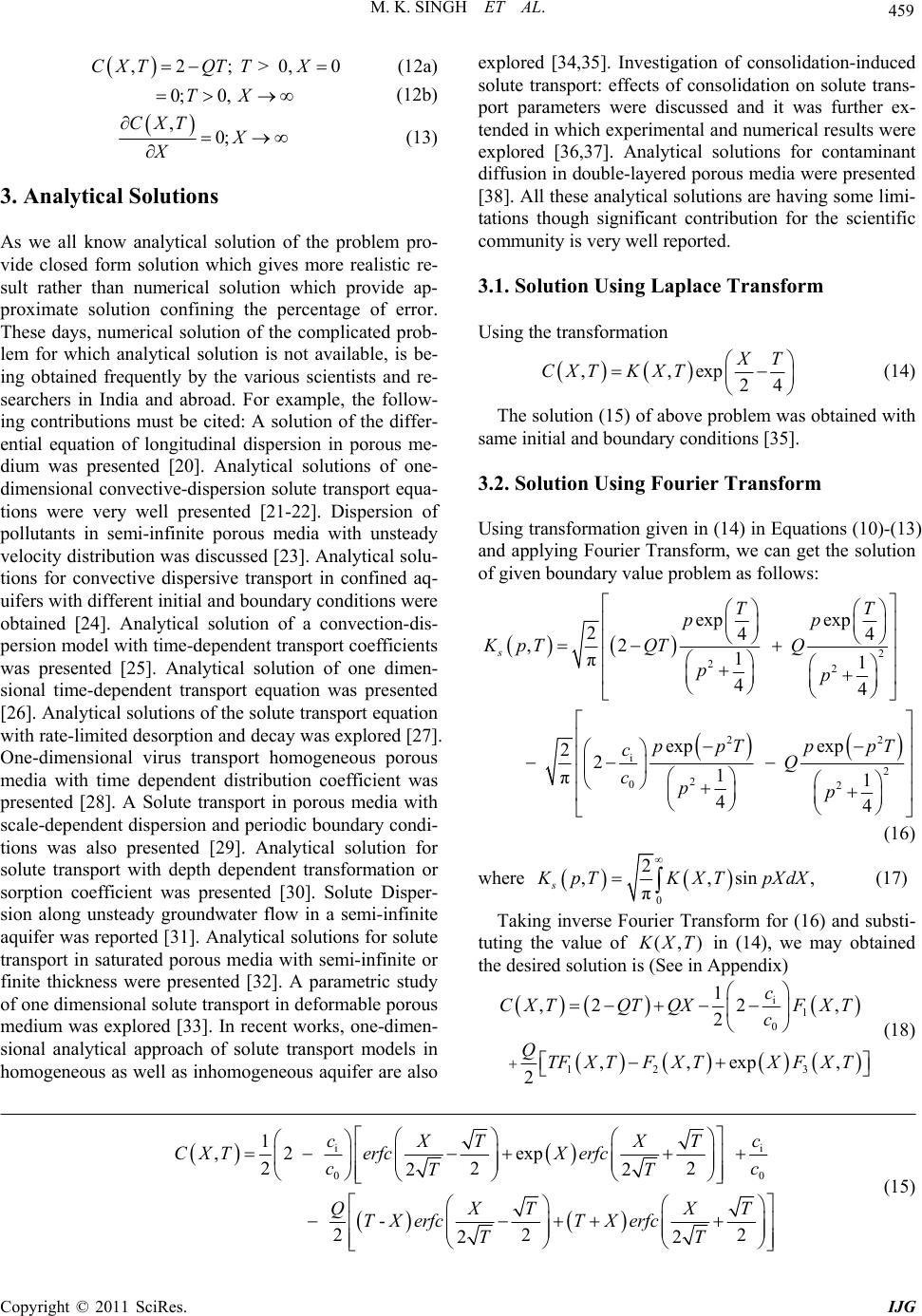 M. K. SINGH ET AL. Copyright © 2011 SciRes. IJG 459 ,2; > 0, 0 CXTQTT X (12a) 0;0, TX (12b) ,0; CXT X X (13) 3. Analytical Solutions As we all know analytical solution of the problem pro- vide closed form solution which gives more realistic re- sult rather than numerical solution which provide ap- proximate solution confining the percentage of error. These days, numerical solution of the complicated prob- lem for which analytical solution is not available, is be- ing obtained frequently by the various scientists and re- searchers in India and abroad. For example, the follow- ing contributions must be cited: A solution of the differ- ential equation of longitudinal dispersion in porous me- dium was presented [20]. Analytical solutions of one- dimensional convective-dispersion solute transport equa- tions were very well presented [21-22]. Dispersion of pollutants in semi-infinite porous media with unsteady velocity distribution was discussed [23]. Analytical solu- tions for convective dispersive transport in confined aq- uifers with different initial and boundary conditions were obtained [24]. Analytical solution of a convection-dis- persion model with time-dependent transport coefficients was presented [25]. Analytical solution of one dimen- sional time-dependent transport equation was presented [26]. Analytical solutions of the solute transport equation with rate-limited desorption and decay was explored [27]. One-dimensional virus transport homogeneous porous media with time dependent distribution coefficient was presented [28]. A Solute transport in porous media with scale-dependent dispersion and periodic boundary condi- tions was also presented [29]. Analytical solution for solute transport with depth dependent transformation or sorption coefficient was presented [30]. Solute Disper- sion along unsteady groundwater flow in a semi-infinite aquifer was reported [31]. Analytical solutions for solute transport in saturated porous media with semi-infinite or finite thickness were presented [32]. A parametric study of one dimensional solute transport in deformable porous medium was explored [33]. In recent works, one-dimen- sional analytical approach of solute transport models in homogeneous as well as inhomogeneous aquifer are also explored [34,35]. Investigation of consolidation-induced solute transport: effects of consolidation on solute trans- port parameters were discussed and it was further ex- tended in which experimental and numerical results were explored [36,37]. Analytical solutions for contaminant diffusion in double-layered porous media were presented [38]. All these analytical solutions are having some limi- tations though significant contribution for the scientific community is very well reported. 3.1. Solution Using Laplace Transform Using the transformation ,,exp 24 X T CXTKXT (14) The solution (15) of above problem was obtained with same initial and boundary conditions [35]. 3.2. Solution Using Fourier Transform Using transformation given in (14) in Equations (10)-(13) and applying Fourier Transform, we can get the solution of given boundary value problem as follows: 2 22 22 i 2 2 02 exp exp 244 ,2 1 π1 44 exp exp 2 2 1 π1 44 s TT pp KpT QTQ pp ppT ppT cQ cpp (16) where 0 2 ,,sin, π s K pTKXTpXdX (17) Taking inverse Fourier Transform for (16) and substi- tuting the value of (,) K XT in (14), we may obtained the desired solution is (See in Appendix) i 1 0 12 3 1 ,22 , 2 ,,exp, 2 c CXTQT QXFXT c QTFXTFX TXFXT (18) i i 0 0 1 ,2 exp 22 2 22 - 22 2 22 ccXT XT CXT erfcXerfc cc TT QXTXT TXerfcT Xerfc TT (15) 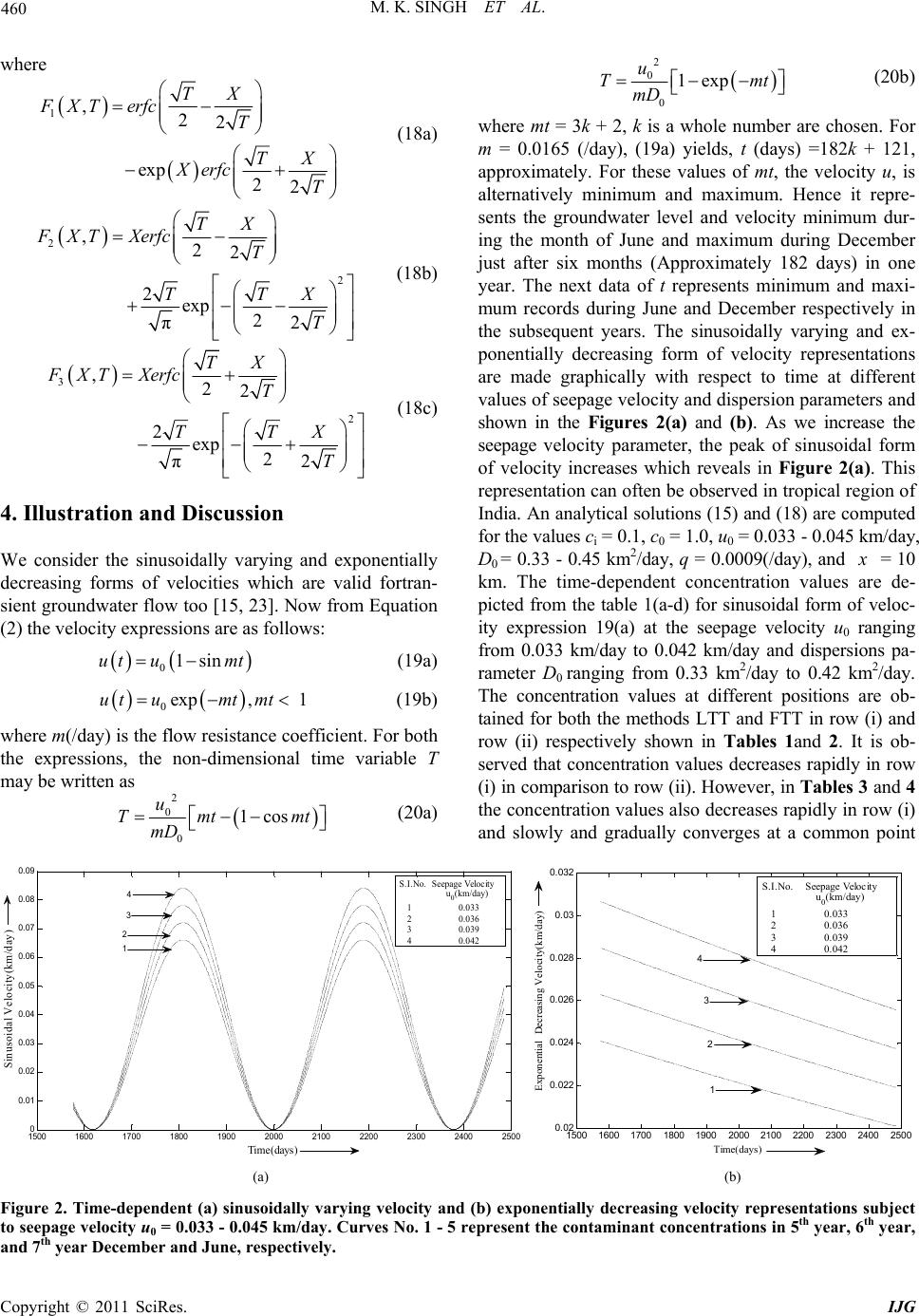 M. K. SINGH ET AL. Copyright © 2011 SciRes. IJG 460 where 1,22 exp22 TX FXT erfcT TX Xerfc T (18a) 2 2 ,22 2 exp2 π2 TX FXT XerfcT TTX T (18b) 3 2 ,22 2 exp2 π2 TX FXT XerfcT TTX T (18c) 4. Illustration and Discussion We consider the sinusoidally varying and exponentially decreasing forms of velocities which are valid fortran- sient groundwater flow too [15, 23]. Now from Equation (2) the velocity expressions are as follows: 01sinutumt (19a) 0exp, 1utumt mt (19b) where m(/day) is the flow resistance coefficient. For both the expressions, the non-dimensional time variable T may be written as 2 0 0 1cos u Tmt mt mD (20a) 2 0 0 1exp u Tmt mD (20b) where mt = 3k + 2, k is a whole number are chosen. For m = 0.0165 (/day), (19a) yields, t (days) =182k + 121, approximately. For these values of mt, the velocity u, is alternatively minimum and maximum. Hence it repre- sents the groundwater level and velocity minimum dur- ing the month of June and maximum during December just after six months (Approximately 182 days) in one year. The next data of t represents minimum and maxi- mum records during June and December respectively in the subsequent years. The sinusoidally varying and ex- ponentially decreasing form of velocity representations are made graphically with respect to time at different values of seepage velocity and dispersion parameters and shown in the Figures 2(a) and (b). As we increase the seepage velocity parameter, the peak of sinusoidal form of velocity increases which reveals in Figure 2(a). This representation can often be observed in tropical region of India. An analytical solutions (15) and (18) are computed for the values ci = 0.1, c0 = 1.0, u0 = 0.033 - 0.045 km/day, D0 = 0.33 - 0.45 km2/day, q = 0.0009(/day), and x = 10 km. The time-dependent concentration values are de- picted from the table 1(a-d) for sinusoidal form of veloc- ity expression 19(a) at the seepage velocity u 0 ranging from 0.033 km/day to 0.042 km/day and dispersions pa- rameter D0 ranging from 0.33 km2/day to 0.42 km2/day. The concentration values at different positions are ob- tained for both the methods LTT and FTT in row (i) and row (ii) respectively shown in Tables 1and 2. It is ob- served that concentration values decreases rapidly in row (i) in comparison to row (ii). However, in Tab les 3 and 4 the concentration values also decreases rapidly in row (i) and slowly and gradually converges at a common point 15001600 1700 1800 1900 2000 2100 2200 2300 2400 2500 0 0.01 0.02 0.03 0.04 0.05 0.06 0.07 0.08 0.09 Time ( da y s ) Sinusoidal Velocity(km/day) 3 4 2 1 S.I.No. Seepage Velocity u 0 (km/day) 1 0.033 2 0.036 3 0.039 4 0.042 1500 1600 17001800 190020002100 2200 230024002500 0.02 0.022 0.024 0.026 0.028 0.03 0.032 Time(days) Exponential Decreasing Velocity(km/day) 4 3 2 1 S.I.No. Seepage Velocity u 0 (km/day) 1 0.033 2 0.036 3 0.039 4 0.042 (a) (b) Figure 2. Time-dependent (a) sinusoidally varying velocity and (b) exponentially decreasing velocity representations subject to seepage velocity u0 = 0.033 - 0.045 km/day. Curves No. 1 - 5 represent the contaminant concentrations in 5th year, 6th year, and 7th year December and June, respectively. 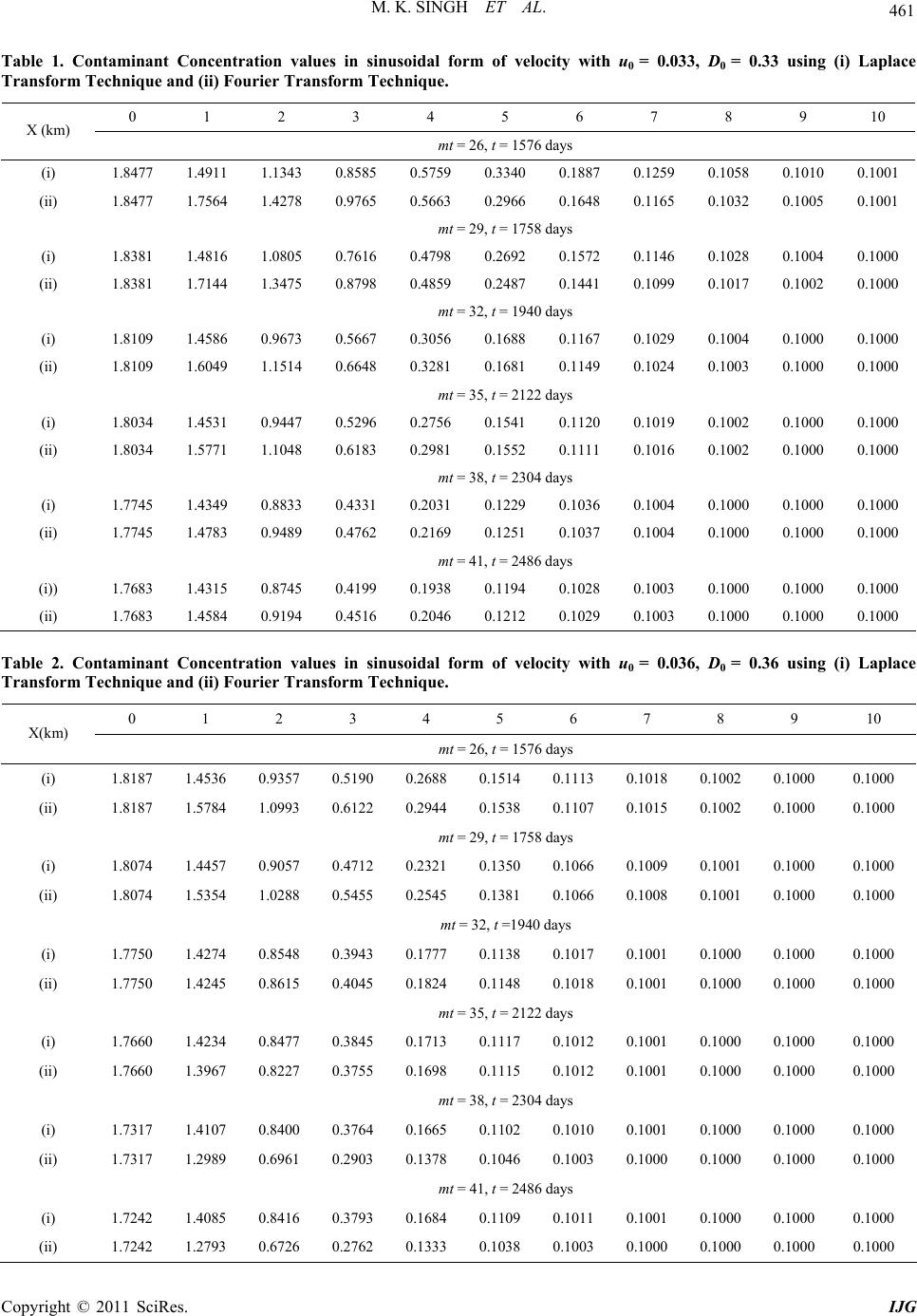 M. K. SINGH ET AL. Copyright © 2011 SciRes. IJG 461 Table 1. Contaminant Concentration values in sinusoidal form of velocity with u0 = 0.033, D0 = 0.33 using (i) Laplace Transform Technique and (ii) Fourier Tr ansfor m Tec hnique. 0 1 2 3 4 5 6 7 8 9 10 X (km) mt = 26, t = 1576 days (i) 1.8477 1.4911 1.1343 0.8585 0.5759 0.3340 0.1887 0.1259 0.1058 0.1010 0.1001 (ii) 1.8477 1.7564 1.4278 0.9765 0.5663 0.2966 0.1648 0.1165 0.1032 0.1005 0.1001 mt = 29, t = 1758 days (i) 1.8381 1.4816 1.0805 0.7616 0.4798 0.2692 0.1572 0.1146 0.1028 0.1004 0.1000 (ii) 1.8381 1.7144 1.3475 0.8798 0.4859 0.2487 0.1441 0.1099 0.1017 0.1002 0.1000 mt = 32, t = 1940 days (i) 1.8109 1.4586 0.9673 0.5667 0.3056 0.1688 0.1167 0.1029 0.1004 0.1000 0.1000 (ii) 1.8109 1.6049 1.1514 0.6648 0.3281 0.1681 0.1149 0.1024 0.1003 0.1000 0.1000 mt = 35, t = 2122 days (i) 1.8034 1.4531 0.9447 0.5296 0.2756 0.1541 0.1120 0.1019 0.1002 0.1000 0.1000 (ii) 1.8034 1.5771 1.1048 0.6183 0.2981 0.1552 0.1111 0.1016 0.1002 0.1000 0.1000 mt = 38, t = 2304 days (i) 1.7745 1.4349 0.8833 0.4331 0.2031 0.1229 0.1036 0.1004 0.1000 0.1000 0.1000 (ii) 1.7745 1.4783 0.9489 0.4762 0.2169 0.1251 0.1037 0.1004 0.1000 0.1000 0.1000 mt = 41, t = 2486 days (i)) 1.7683 1.4315 0.8745 0.4199 0.1938 0.1194 0.1028 0.1003 0.1000 0.1000 0.1000 (ii) 1.7683 1.4584 0.9194 0.4516 0.2046 0.1212 0.1029 0.1003 0.1000 0.1000 0.1000 Table 2. Contaminant Concentration values in sinusoidal form of velocity with u0 = 0.036, D0 = 0.36 using (i) Laplace Transform Technique and (ii) Fourier Tr ansfor m Tec hnique. 0 1 2 3 4 5 6 7 8 9 10 X(km) mt = 26, t = 1576 days (i) 1.8187 1.4536 0.9357 0.5190 0.2688 0.1514 0.1113 0.1018 0.1002 0.1000 0.1000 (ii) 1.8187 1.5784 1.0993 0.6122 0.2944 0.1538 0.1107 0.1015 0.1002 0.1000 0.1000 mt = 29, t = 1758 days (i) 1.8074 1.4457 0.9057 0.4712 0.2321 0.1350 0.1066 0.1009 0.1001 0.1000 0.1000 (ii) 1.8074 1.5354 1.0288 0.5455 0.2545 0.1381 0.1066 0.1008 0.1001 0.1000 0.1000 mt = 32, t =1940 days (i) 1.7750 1.4274 0.8548 0.3943 0.1777 0.1138 0.1017 0.1001 0.1000 0.1000 0.1000 (ii) 1.7750 1.4245 0.8615 0.4045 0.1824 0.1148 0.1018 0.1001 0.1000 0.1000 0.1000 mt = 35, t = 2122 days (i) 1.7660 1.4234 0.8477 0.3845 0.1713 0.1117 0.1012 0.1001 0.1000 0.1000 0.1000 (ii) 1.7660 1.3967 0.8227 0.3755 0.1698 0.1115 0.1012 0.1001 0.1000 0.1000 0.1000 mt = 38, t = 2304 days (i) 1.7317 1.4107 0.8400 0.3764 0.1665 0.1102 0.1010 0.1001 0.1000 0.1000 0.1000 (ii) 1.7317 1.2989 0.6961 0.2903 0.1378 0.1046 0.1003 0.1000 0.1000 0.1000 0.1000 mt = 41, t = 2486 days (i) 1.7242 1.4085 0.8416 0.3793 0.1684 0.1109 0.1011 0.1001 0.1000 0.1000 0.1000 (ii) 1.7242 1.2793 0.6726 0.2762 0.1333 0.1038 0.1003 0.1000 0.1000 0.1000 0.1000 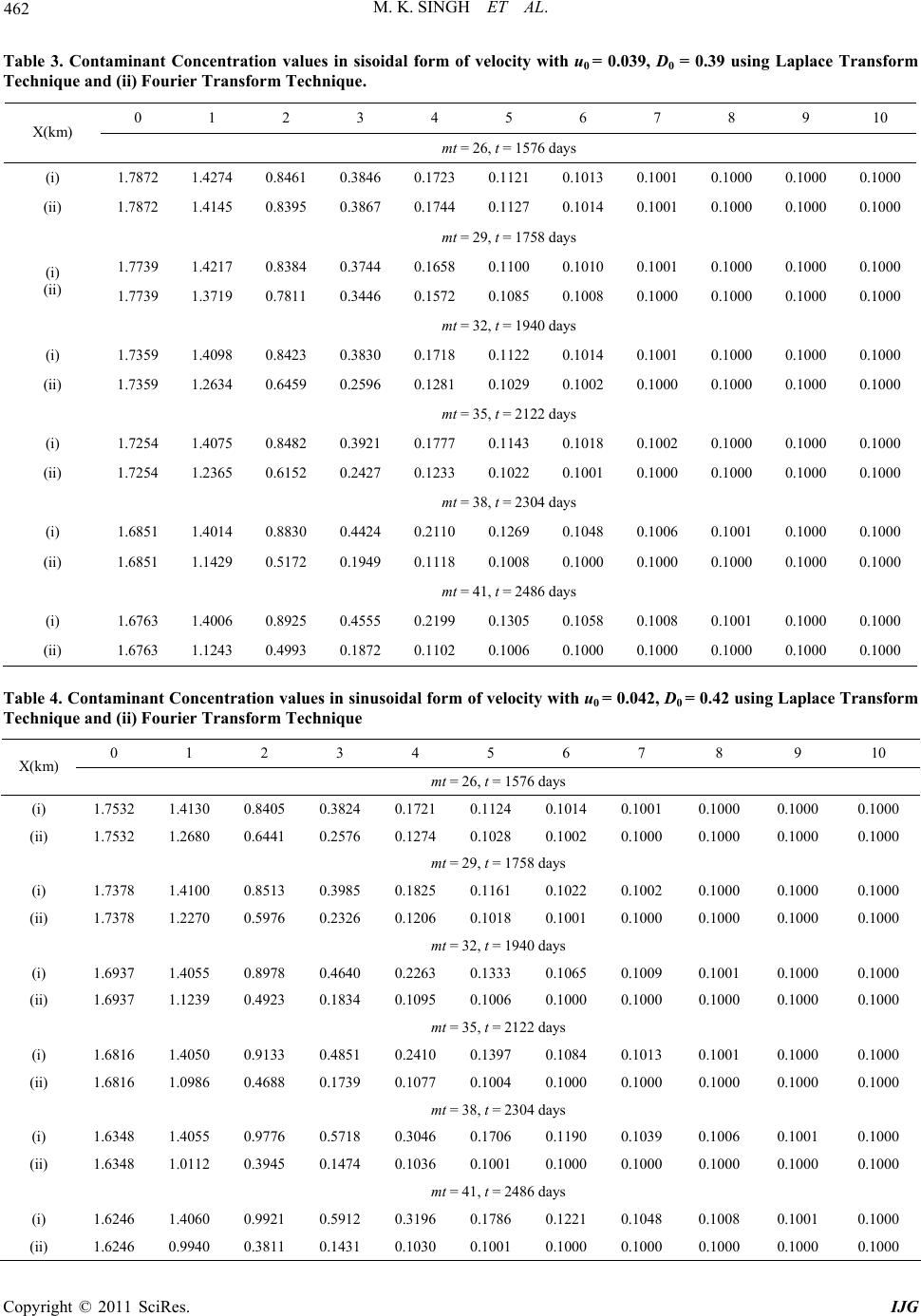 M. K. SINGH ET AL. Copyright © 2011 SciRes. IJG 462 Table 3. Contaminant Concentration values in sisoidal form of velocity with u0 = 0.039, D0 = 0.39 using Laplace Transform Technique and (ii) Fourier Transfor m Technique. 0 1 2 3 4 5 6 7 8 9 10 X(km) mt = 26, t = 1576 days (i) 1.7872 1.4274 0.8461 0.3846 0.1723 0.1121 0.1013 0.1001 0.1000 0.1000 0.1000 (ii) 1.7872 1.4145 0.8395 0.3867 0.1744 0.1127 0.1014 0.1001 0.1000 0.1000 0.1000 mt = 29, t = 1758 days 1.7739 1.4217 0.8384 0.3744 0.1658 0.1100 0.1010 0.1001 0.1000 0.1000 0.1000 (i) (ii) 1.7739 1.3719 0.7811 0.3446 0.1572 0.1085 0.1008 0.1000 0.1000 0.1000 0.1000 mt = 32, t = 1940 days (i) 1.7359 1.4098 0.8423 0.3830 0.1718 0.1122 0.1014 0.1001 0.1000 0.1000 0.1000 (ii) 1.7359 1.2634 0.6459 0.2596 0.1281 0.1029 0.1002 0.1000 0.1000 0.1000 0.1000 mt = 35, t = 2122 days (i) 1.7254 1.4075 0.8482 0.3921 0.1777 0.1143 0.1018 0.1002 0.1000 0.1000 0.1000 (ii) 1.7254 1.2365 0.6152 0.2427 0.1233 0.1022 0.1001 0.1000 0.1000 0.1000 0.1000 mt = 38, t = 2304 days (i) 1.6851 1.4014 0.8830 0.4424 0.2110 0.1269 0.1048 0.1006 0.1001 0.1000 0.1000 (ii) 1.6851 1.1429 0.5172 0.1949 0.1118 0.1008 0.1000 0.1000 0.1000 0.1000 0.1000 mt = 41, t = 2486 days (i) 1.6763 1.4006 0.8925 0.4555 0.2199 0.1305 0.1058 0.1008 0.1001 0.1000 0.1000 (ii) 1.6763 1.1243 0.4993 0.1872 0.1102 0.1006 0.1000 0.1000 0.1000 0.1000 0.1000 Table 4. Contaminant Concentration values in sinusoidal form of velocity with u0 = 0.042, D0 = 0.42 using Laplace Transform Technique and (ii) Fourier Transfor m Technique 0 1 2 3 4 5 6 7 8 9 10 X(km) mt = 26, t = 1576 days (i) 1.7532 1.4130 0.8405 0.3824 0.1721 0.1124 0.1014 0.1001 0.1000 0.1000 0.1000 (ii) 1.7532 1.2680 0.6441 0.2576 0.1274 0.1028 0.1002 0.1000 0.1000 0.1000 0.1000 mt = 29, t = 1758 days (i) 1.7378 1.4100 0.8513 0.3985 0.1825 0.1161 0.1022 0.1002 0.1000 0.1000 0.1000 (ii) 1.7378 1.2270 0.5976 0.2326 0.1206 0.1018 0.1001 0.1000 0.1000 0.1000 0.1000 mt = 32, t = 1940 days (i) 1.6937 1.4055 0.8978 0.4640 0.2263 0.1333 0.1065 0.1009 0.1001 0.1000 0.1000 (ii) 1.6937 1.1239 0.4923 0.1834 0.1095 0.1006 0.1000 0.1000 0.1000 0.1000 0.1000 mt = 35, t = 2122 days (i) 1.6816 1.4050 0.9133 0.4851 0.2410 0.1397 0.1084 0.1013 0.1001 0.1000 0.1000 (ii) 1.6816 1.0986 0.4688 0.1739 0.1077 0.1004 0.1000 0.1000 0.1000 0.1000 0.1000 mt = 38, t = 2304 days (i) 1.6348 1.4055 0.9776 0.5718 0.3046 0.1706 0.1190 0.1039 0.1006 0.1001 0.1000 (ii) 1.6348 1.0112 0.3945 0.1474 0.1036 0.1001 0.1000 0.1000 0.1000 0.1000 0.1000 mt = 41, t = 2486 days (i) 1.6246 1.4060 0.9921 0.5912 0.3196 0.1786 0.1221 0.1048 0.1008 0.1001 0.1000 (ii) 1.6246 0.9940 0.3811 0.1431 0.1030 0.1001 0.1000 0.1000 0.1000 0.1000 0.1000 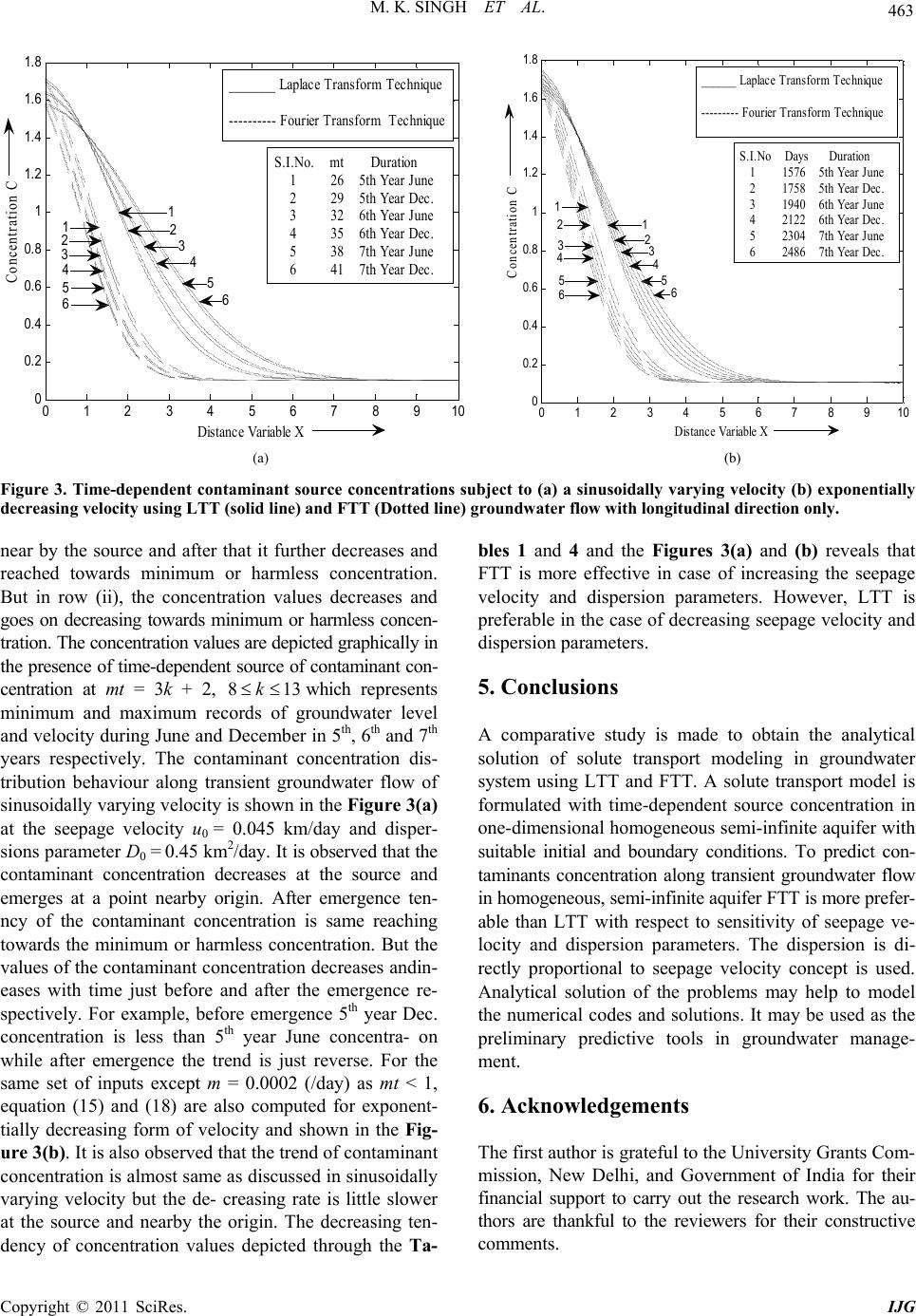 M. K. SINGH ET AL. Copyright © 2011 SciRes. IJG 463 0 1 23 45 6 78910 0 0. 2 0. 4 0. 6 0. 8 1 1. 2 1. 4 1. 6 1. 8 Distance Variable X Concentration C 34 56 _______ Laplace Transform Technique ---------- Fourier Transform Technique 3 4 5 2 S.I.No. mt Duration 1 26 5th Year June 2 29 5th Year Dec. 3 32 6th Year June 4 35 6th Year Dec. 5 38 7th Year June 6 41 7th Year Dec. 1 6 1 2 0 1 23 45 6 78 910 0 0. 2 0. 4 0. 6 0. 8 1 1. 2 1. 4 1. 6 1. 8 Distance Variable X Concentration C S.I.No Days Duration 1 1576 5th Year June 2 1758 5th Year Dec. 3 1940 6th Year June 4 2122 6th Year Dec. 5 2304 7th Year June 6 2486 7th Year Dec. 1 2 3 5 4 6 2 3456 1 ______ Laplace Transform Technique --------- Fourier Transform Technique (a) (b) Figure 3. Time-dependent contaminant source concentrations subject to (a) a sinusoidally varying velocity (b) exponentially decreasing velocity using LTT (solid line) and FTT (Dotted line) groundwater flow with longitudinal direction only. near by the source and after that it further decreases and reached towards minimum or harmless concentration. But in row (ii), the concentration values decreases and goes on decreasing towards minimum or harmless concen- tration. The concentration values are depicted graphically in the presence of time-dependent source of contaminant con- centration at mt = 3k + 2, 813k which represents minimum and maximum records of groundwater level and velocity during June and December in 5th, 6th and 7th years respectively. The contaminant concentration dis- tribution behaviour along transient groundwater flow of sinusoidally varying velocity is shown in the Figure 3(a) at the seepage velocity u 0 = 0.045 km/day and disper- sions parameter D0 = 0.45 km2/day. It is observed that the contaminant concentration decreases at the source and emerges at a point nearby origin. After emergence ten- ncy of the contaminant concentration is same reaching towards the minimum or harmless concentration. But the values of the contaminant concentration decreases andin- eases with time just before and after the emergence re- spectively. For example, before emergence 5th year Dec. concentration is less than 5th year June concentra- on while after emergence the trend is just reverse. For the same set of inputs except m = 0.0002 (/day) as mt < 1, equation (15) and (18) are also computed for exponent- tially decreasing form of velocity and shown in the Fig- ure 3(b). It is also observed that the trend of contaminant concentration is almost same as discussed in sinusoidally varying velocity but the de- creasing rate is little slower at the source and nearby the origin. The decreasing ten- dency of concentration values depicted through the Ta- bles 1 and 4 and the Figures 3(a) and (b) reveals that FTT is more effective in case of increasing the seepage velocity and dispersion parameters. However, LTT is preferable in the case of decreasing seepage velocity and dispersion parameters. 5. Conclusions A comparative study is made to obtain the analytical solution of solute transport modeling in groundwater system using LTT and FTT. A solute transport model is formulated with time-dependent source concentration in one-dimensional homogeneous semi-infinite aquifer with suitable initial and boundary conditions. To predict con- taminants concentration along transient groundwater flow in homogeneous, semi-infinite aquifer FTT is more prefer- able than LTT with respect to sensitivity of seepage ve- locity and dispersion parameters. The dispersion is di- rectly proportional to seepage velocity concept is used. Analytical solution of the problems may help to model the numerical codes and solutions. It may be used as the preliminary predictive tools in groundwater manage- ment. 6. Acknowledgements The first author is grateful to the University Grants Com- mission, New Delhi, and Government of India for their financial support to carry out the research work. The au- thors are thankful to the reviewers for their constructive comments. 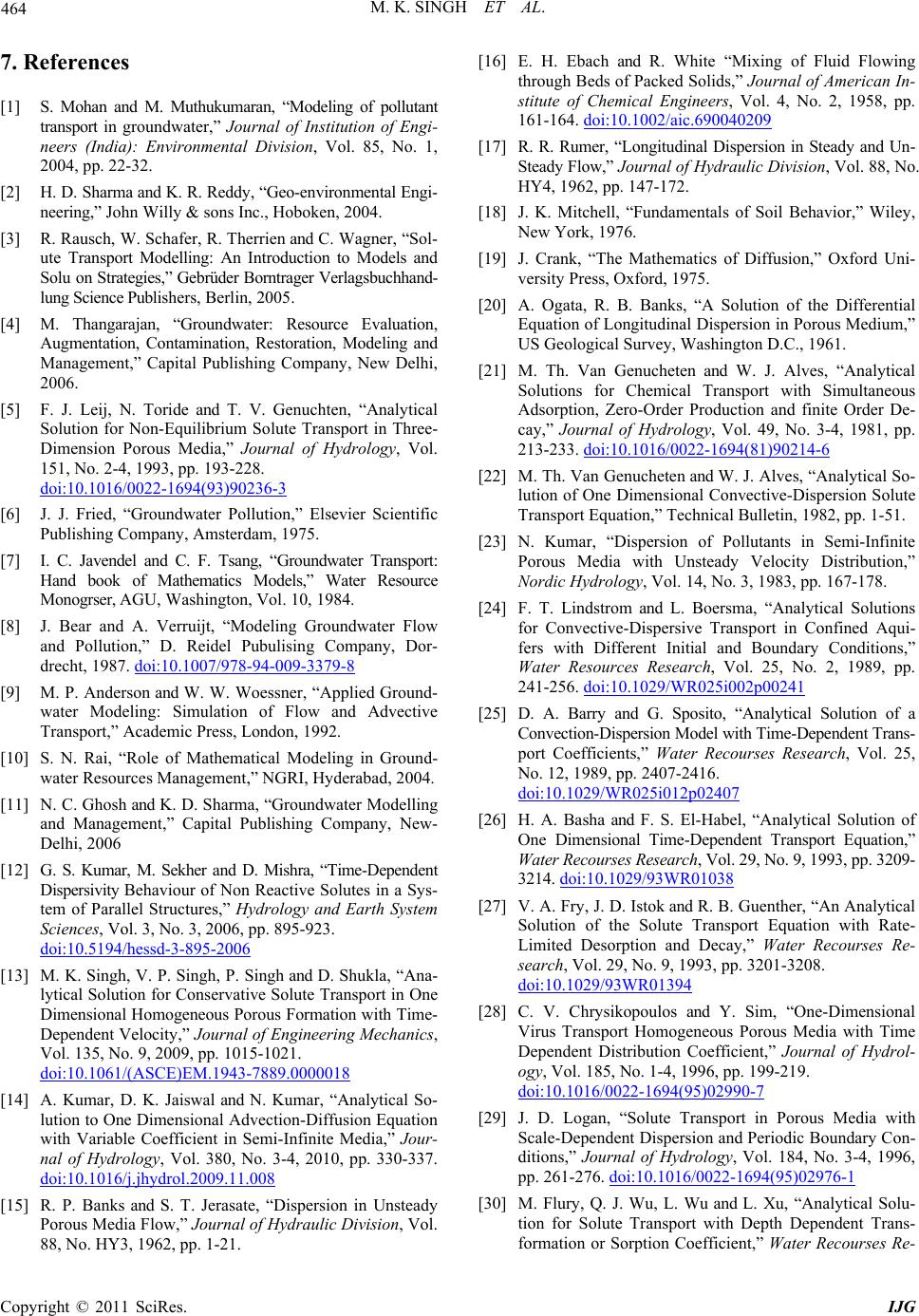 M. K. SINGH ET AL. Copyright © 2011 SciRes. IJG 464 7. References [1] S. Mohan and M. Muthukumaran, “Modeling of pollutant transport in groundwater,” Journal of Institution of Engi- neers (India): Environmental Division, Vol. 85, No. 1, 2004, pp. 22-32. [2] H. D. Sharma and K. R. Reddy, “Geo-en vironmental Engi- neering,” John Willy & sons Inc., Hoboken, 2004. [3] R. Rausch, W. Schafer, R. Therrien and C. Wagner, “Sol- ute Transport Modelling: An Introduction to Models and Solu on Strategies,” Gebrüder Borntrager Verlagsbuchhand- lu ng Sc ie nc e Pu bl ishers , Berlin, 2005. [4] M. Thangarajan, “Groundwater: Resource Evaluation, Augmentation, Contamination, Restoration, Modeling and Management,” Capital Publishing Company, New Delhi, 2006. [5] F. J. Leij, N. Toride and T. V. Genuchten, “Analytical Solution for Non-Equilibrium Solute Transport in Three- Dimension Porous Media,” Journal of Hydrology, Vol. 151, No. 2-4, 1993, pp. 193-228. doi:10.1016/0022-1694(93)90236-3 [6] J. J. Fried, “Groundwater Pollution,” Elsevier Scientific Publishing Company, Amsterdam, 1975. [7] I. C. Javendel and C. F. Tsang, “Groundwater Transport: Hand book of Mathematics Models,” Water Resource Monogrser, AGU, Washington, Vol. 10, 1984. [8] J. Bear and A. Verruijt, “Modeling Groundwater Flow and Pollution,” D. Reidel Pubulising Company, Dor- drecht, 1987. doi:10.1007/978-94-009-3379-8 [9] M. P. Anderson and W. W. Woessner, “Applied Ground- water Modeling: Simulation of Flow and Advective Transport,” Academic Press, London, 1992. [10] S. N. Rai, “Role of Mathematical Modeling in Ground- water Resources Management,” NGRI, Hyderabad, 2004. [11] N. C. Ghosh and K. D. Sharma, “Groundwater Modelling and Management,” Capital Publishing Company, New- Delhi, 2006 [12] G. S. Kumar, M. Sekher and D. Mishra, “Time-Dependent Dispersivity Behaviour of Non Reactive Solutes in a Sys- tem of Parallel Structures,” Hydrology and Earth System Sciences, Vol. 3, No. 3, 2006, pp. 895-923. doi:10.5194/hessd-3-895-2006 [13] M. K. Singh, V. P. Singh, P. Singh and D. Shukla, “Ana- lytical Solution for Conservative Solute Transport in One Dimensional Homogeneous Poro us Formation with Time- Dependent Velocity,” Journal of Engineering Mechanics, Vol. 135, No. 9, 2009, pp. 1015-1021. doi:10.1061/(ASCE)EM.1943-7889.0000018 [14] A. Kumar, D. K. Jaiswal and N. Kumar, “Analytical So- lution to One Dimensional Advection-Diffusion Equation with Variable Coefficient in Semi-Infinite Media,” Jour- nal of Hydrology, Vol. 380, No. 3-4, 2010, pp. 330-337. doi:10.1016/j.jhydrol.2009.11.008 [15] R. P. Banks and S. T. Jerasate, “Dispersion in Unsteady Porous Media Flow,” Journal of Hydraulic Division, Vol. 88, No. HY3, 1962, pp. 1-21. [16] E. H. Ebach and R. White “Mixing of Fluid Flowing through Beds of Packed Solids,” Journal of American In- stitute of Chemical Engineers, Vol. 4, No. 2, 1958, pp. 161-164. doi:10.1002/aic.690040209 [17] R. R. Rumer, “Longitudinal Dispersion in Steady and Un- Steady Flow,” Journal of Hydraulic Division, Vol. 88, No. HY4, 1962, pp. 147-172. [18] J. K. Mitchell, “Fundamentals of Soil Behavior,” Wiley, New York, 1976. [19] J. Crank, “The Mathematics of Diffusion,” Oxford Uni- versity Press, Oxford, 1975. [20] A. Ogata, R. B. Banks, “A Solution of the Differential Equation of Longitudinal Dispersion in Porous Medium,” US Geological Survey, Washington D.C., 1961. [21] M. Th. Van Genucheten and W. J. Alves, “Analytical Solutions for Chemical Transport with Simultaneous Adsorption, Zero-Order Production and finite Order De- cay,” Journal of Hydrology, Vol. 49, No. 3-4, 1981, pp. 213-233. doi:10.1016/0022-1694(81)90214-6 [22] M. Th. Van Genucheten and W. J. Alves, “Analytical So- lution of One Dimensional Convective-Dispersion Solute Transport Equation,” Technical Bulletin, 1982, pp. 1-51. [23] N. Kumar, “Dispersion of Pollutants in Semi-Infinite Porous Media with Unsteady Velocity Distribution,” Nordic Hydrology, Vol. 14, No. 3, 1983, pp. 167-178. [24] F. T. Lindstrom and L. Boersma, “Analytical Solutions for Convective-Dispersive Transport in Confined Aqui- fers with Different Initial and Boundary Conditions,” Water Resources Research, Vol. 25, No. 2, 1989, pp. 241-256. doi:10.1029/WR025i002p00241 [25] D. A. Barry and G. Sposito, “Analytical Solution of a Convection-Di spersio n Model with Time -Depe ndent Tran s- port Coefficients,” Water Recourses Research, Vol. 25, No. 12, 1989, pp. 2407-2416. doi:10.1029/WR025i012p02407 [26] H. A. Basha and F. S. El-Habel, “Analytical Solution of One Dimensional Time-Dependent Transport Equation,” Water Recourses Research, Vol. 29, No. 9, 1993, pp. 3209- 3214. doi:10.1029/93WR01038 [27] V. A. Fry, J. D. Istok and R. B. Guenther, “An Analytical Solution of the Solute Transport Equation with Rate- Limited Desorption and Decay,” Water Recourses Re- search, Vol. 29, No. 9, 1993, pp. 3201-3208. doi:10.1029/93WR01394 [28] C. V. Chrysikopoulos and Y. Sim, “One-Dimensional Virus Transport Homogeneous Porous Media with Time Dependent Distribution Coefficient,” Journal of Hydrol- ogy, Vol. 185, No. 1-4, 1996, pp. 199-219. doi:10.1016/0022-1694(95)02990-7 [29] J. D. Logan, “Solute Transport in Porous Media with Scale-Dependent Dispersion and Periodic Boundary Con- ditions,” Journal of Hydrology, Vol. 184, No. 3-4, 1996, pp. 261-276. doi:10.1016/0022-1694(95)02976-1 [30] M. Flury, Q. J. Wu, L. Wu and L. Xu, “Analytical Solu- tion for Solute Transport with Depth Dependent Trans- formation or Sorption Coefficient,” Water Recourses Re-  M. K. SINGH ET AL. Copyright © 2011 SciRes. IJG 465 search, Vol. 34, No. 11, 1998, pp. 2931-2937. doi:10.1029/98WR02299 [31] N. Kumar and M. Kumar, “Solute Dispersion along Un- steady Groundwater Flow in a Semi-Infinite Aquifer,” Hy- drology and Earth System Sciences, Vol. 2, No. 1, 1998, pp. 93-100. doi:10.5194/hess-2-93-1998 [32] Y. Sim and C. V. Chrysikopoulos, “Analytical Solutions for Solute Transport In Saturated Porous Media with Semi-Infinite Or Finite Thickness,” Advances in Water Recourses, Vol. 22, No. 5, 1999, pp. 507-519. doi:10.1016/S0309-1708(98)00027-X [33] A. Alshawabkeh and N. Rahbar, “A Parametric Study of One Dimensional Solute Transport in Deformable Porous Medium,” Journal of Geotechnical and Geoenvi ronmental Engineering, Vol. 132, No. 8, 2006, pp. 100-1010. doi:10.1061/(ASCE)1090-0241(2006)132:8(1001) [34] V. Srinivasan and T. P. Clement, “Analytical Solutions for Sequentially Coupled One Dimensional Reactive Transport Problems-Part-I: Mathematical Derivations,” Advances in Water Recourses, Vol. 31, No. 2, 2008, pp. 203-218. doi:10.1016/j.advwatres.2007.08.002 [35] M. K. Singh, N. K. Mahato and P. Singh, “Longitudinal Dispersion with Time Dependent Source Concentration in Semi Infinite Aquifer,” Journal of Earth System Sci- ences, Vol. 117, No. 6, 2008, pp. 945-949. doi:10.1007/s12040-008-0079-x [36] J. Lee, P. J. Fox and J. J. Lenhart, “Investigation of Con- solidation-Induced Solute Transport. I. Effect of Con- solidation on solute Transport Parameters,” Journal of Geotechnical and Geoenvironmental Engineering, Vol. 135, No. 9, 2009, pp. 1228-1238. doi:10.1061/(ASCE)GT.1943-5606.0000047 [37] J. Lee and P. J. Fox, “Investigation of Consolidation- Induced Solute Transport. II. Experimental and Numeri- cal Results,” Journal of Geotechnical and Geoenviron- mental Engineering, Vol. 135, No. 9, 2009, pp. 1239- 1253. doi:10.1061/(ASCE)GT.1943-5606.0000048 [38] Y. C. Li and P. J. Cleall, “Analytical solutions for Con- taminant Diffusion in Double-Layered Porous Media,” Journal of Geotechnical and Geoenvironmental Engi- neering, Vol. 136, No. 11, 2010, pp. 1542-1554. doi:10.1061/(ASCE)GT.1943-5606.0000365 Appendix Analytical Solution using Fourier Transform Tech- nique (FTT): 2 2 ccc Du x t x (1) 0 uuVt (2) The initial and boundary conditions can be expressed as: ,; 0,0 i cxtc xt (3) 0 , 1exp; > 0,0 cxt cqttx (4a) 0; 0, tx (4b) 0 ; cx x (5) Let Dau, where the coefficient of dimension length is a and depends upon pore system geometry and aver- age pore size diameter of porous medium. Using Equation (2), we get0()DDVt.Here 00 Dau is an initial dis- persion coefficient. Equation (1) can now be written as 2 00 2 1 () cc c Du x Vt t x (6) A new time variable is introduced by the transforma- tion [19] * 0 ()dt t TVt (7) And Equation (6) becomes 2 00 2* ccc Du x T x (8) and initial condition (3) and boundary conditions 4(a, b) and (5) becomes ** i ,;0,0cxTcx T (9) *** 0 ,2; > 0, 0 CxTcQTTx (10) * 0;0, Tx (11) * ,0 ; CxT x x (12) Now the set of non dimensional variables are defined as follows 2 00 0 2 00 00 * ,, , x uuT qD c CX TQ cD Du (13) The PDE (8) in the form of non-dimensional variable may be written as 2 2 CCC X T X (14) i 0 ,;0,0 c CXTX T c (15) ,2; > 0, X0 CXTQTT (16) 0 ; 0, XT (17) ,0 ; CXT X X (18) 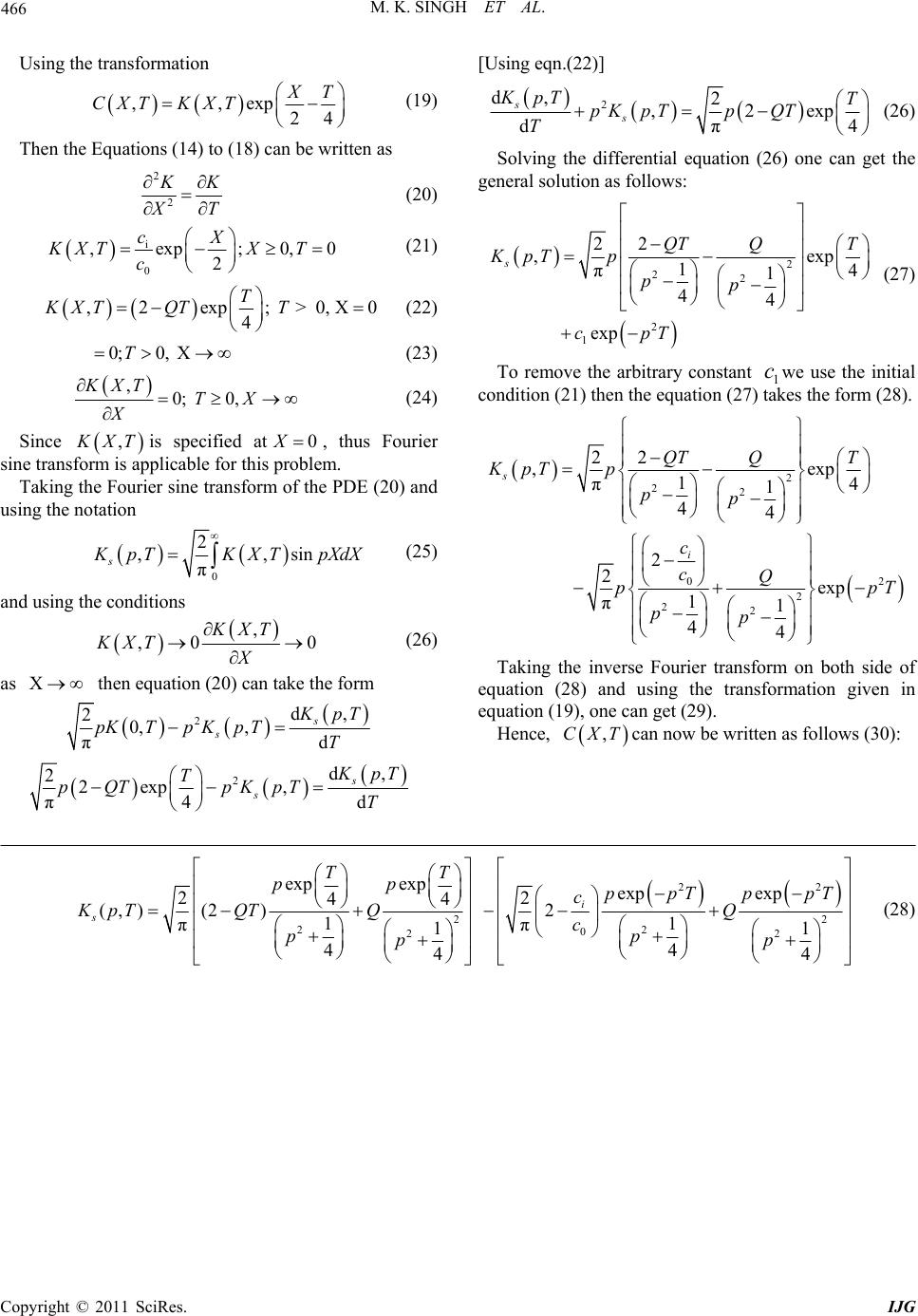 M. K. SINGH ET AL. Copyright © 2011 SciRes. IJG 466 Using the transformation ,,exp 24 X T CXTKXT (19) Then the Equations (14) to (18) can be written as 2 2 K K T X (20) i 0 ,exp;0,0 2 cX KXTX T c (21) ,2exp; > 0, X0 4 T KXT QTT (22) 0;0, XT (23) ,0; 0, KXT TX X (24) Since , K XT is specified at0X, thus Fourier sine transform is applicable for this problem. Taking the Fourier sine transform of the PDE (20) and using the notation 0 2 ,,sin π s K pTK XTpXdX (25) and using the conditions , ,00 K XT KXT X (26) as X then equation (20) can take the form 2d, 20, , πd s s K pT pKTpKp TT 2d, 22exp , π4d s s K pT T pQTpKpT T [Using eqn.(22)] 2 d, 2 ,2exp dπ4 ss KpT T pK pTpQT T (26) Solving the differential equation (26) one can get the general solution as follows: 2 22 2 1 22 ,exp 1 π4 1 44 exp sQT QT KpT p pp cpT (27) To remove the arbitrary constant 1 cwe use the initial condition (21) then the equation (27) takes the form (28). 2 22 02 2 22 22 ,exp 1 π4 1 44 2 2 exp 1 π1 44 s i QT QT KpT p pp c cQ ppT pp Taking the inverse Fourier transform on both side of equation (28) and using the transformation given in equation (19), one can get (29). Hence, ,CXT can now be written as follows (30): 22 22 22 0 22 exp expexp exp 22 44 (,)(2) 2 11 ππ 11 44 44 i s TT pp ppTppT c KpT QTQQ c pp pp (28) 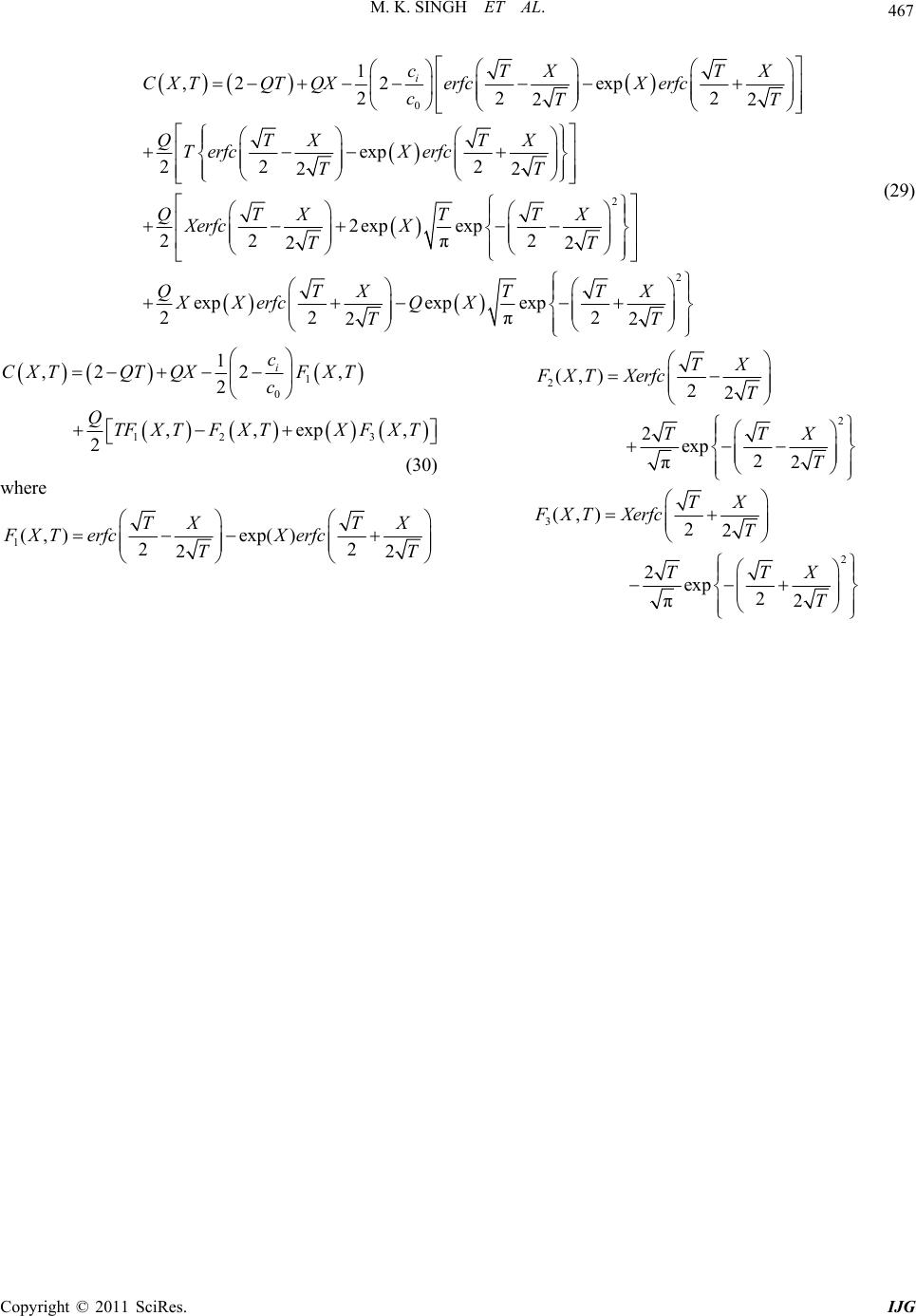 M. K. SINGH ET AL. Copyright © 2011 SciRes. IJG 467 0 2 1 ,2 2exp 22 2 22 exp 22 2 22 2exp exp 22 π2 22 i cTX TX CXTQT QXerfcXerfc cTT QTX TX Terfc Xerfc TT QTX TTX Xerfc X TT 2 expexp exp 22 π2 22 QTXTTX XXerfc QX TT (29) 1 0 12 3 1 ,22 , 2 ,,exp, 2 i c CXTQT QXFXT c QTFX TFX TXFX T (30) where 1(,) exp() 22 22 TX TX FXT erfcXerfc TT 2 2 (,) 22 2 exp2 π2 TX FXTXerfcT TTX T 3 2 (,) 22 2 exp2 π2 TX FXTXerfcT TTX T |

